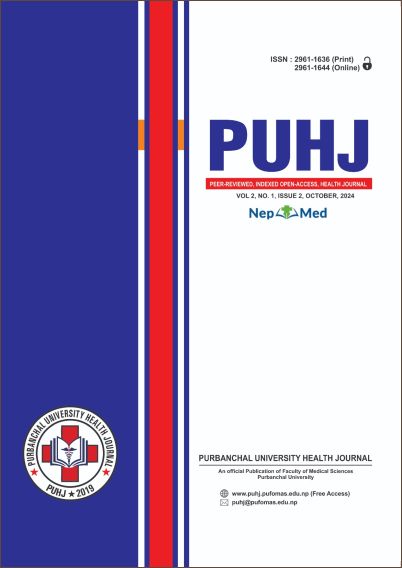Antibiotic Susceptibility Pattern Among Cancer Patients with Urinary Tract Infection at a Tertiary Cancer Hospital in Nepal
DOI:
https://doi.org/10.3126/puhj.v2i1.74944Keywords:
Antibiotic Susceptibility, Bacteria, Cancer, Urinary Tract InfectionAbstract
Background: Cancer patients are at a higher risk of infection due to the nature of treatment modalities used that lead to immunosuppression. Urinary tract infections are the most common cause of morbidity among cancer patients.
Objective: The objective of this study is to determine antibiotic sensitivity and resistance pattern in cancer patients with urinary tract infections at a tertiary cancer hospital in Nepal.
Method: A retrospective analysis was conducted on cancer patients with urinary tract infections from September 2020 to June 2024 at a tertiary cancer hospital in Nepal. Antibiotic susceptibility testing was performed using the Kirby-Bauer disk diffusion method. Data on positive urine cultures were extracted from the medical laboratory system. Bacterial profiles and antibiotic susceptibility test results were assessed. Data were analyzed using R-statistical software.
Result: A total of 613 urine cultures were performed during the study period among which 116 were positive cultures. After excluding ineligible cultures, 102 (16.63%) positive cultures from 97 patients were included. Most of the patients were females (79.38%). The most common cancers were gynecological (43.39%) followed by genitourinary (9.28%), central nervous system (9.28%) and lung (8.25%) cancers. The most isolated bacteria were Escherichia coli (62.88%) followed by Klebsiella pneumonia (14.43%). The most sensitive antibiotics were Amikacin (68.42%), Nitrofurantoin (63.54%), Gentamicin (41.43%), Co-trimoxazole (40.63%), Ofloxacin (38.10%), Amoxicillin/Clavulanate (31.51%), Norfloxacin (26.09%), Ciprofloxacin (20.93%), Cefixime (13.85%) and Amoxicillin (8.33%) while the antibiotics in reverse order were most resistant antibiotics among top 10 tested antibiotics.
Conclusion: The findings of this study can guide clinicians to make an informed decision in the selection of antibiotics and management of urinary tract infections in cancer patients.
Downloads
Downloads
Published
How to Cite
Issue
Section
License
Copyright (c) 2024 The Author(s)

This work is licensed under a Creative Commons Attribution-NonCommercial 4.0 International License.
This license enables reusers to distribute, remix, adapt, and build upon the material in any medium or format for noncommercial purposes only, and only so long as attribution is given to the creator.




